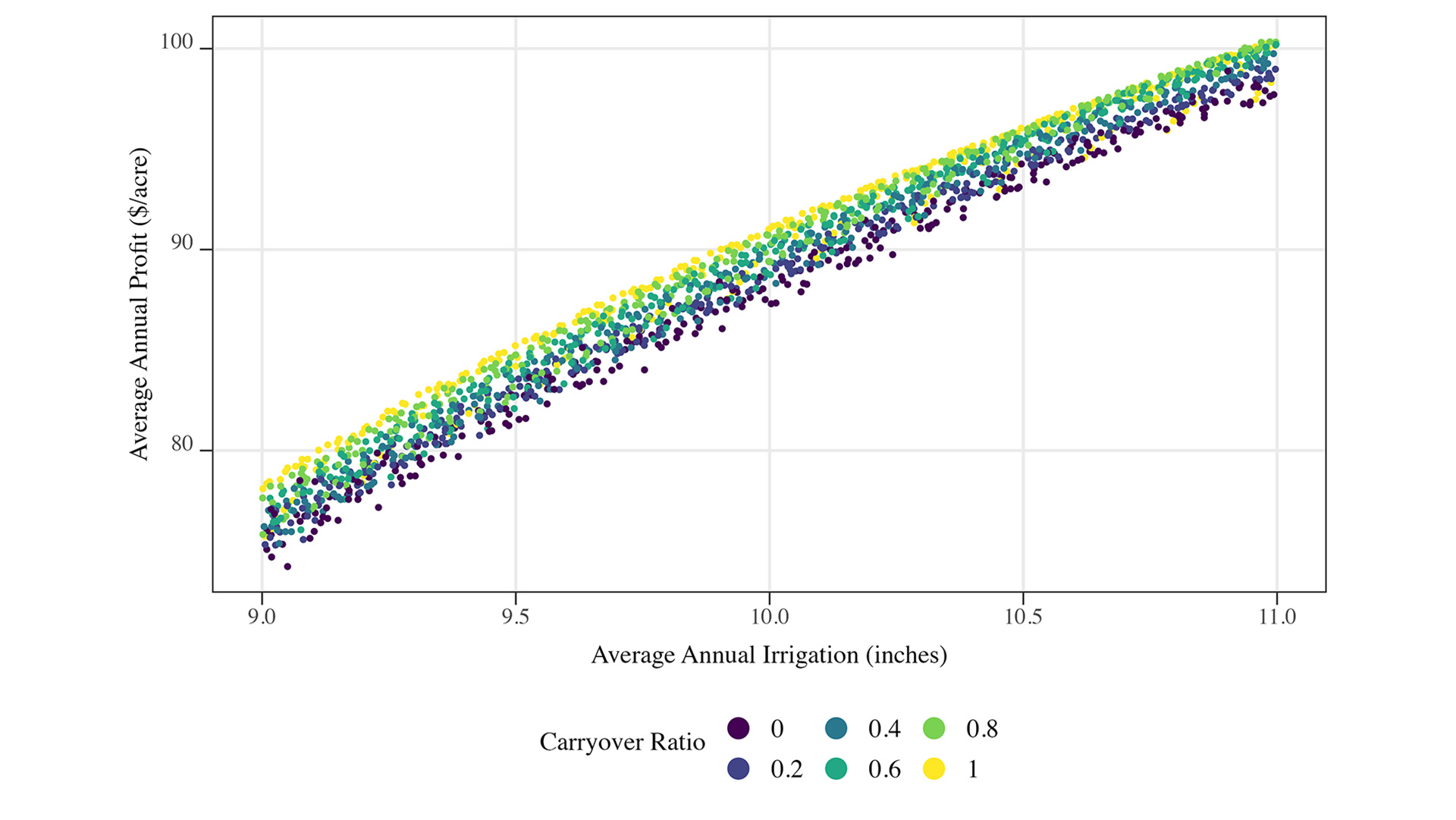One of the goals of Daugherty Water for Food Global Institute (DWFI) researchers is to understand how to make agricultural water policy as effective as possible. This goal can be supported by combining on-the-ground knowledge with theoretical and conceptual economic models to explore how people will respond to actual and potential policies.
Groundwater management in agriculture is a hot topic globally. Whether in California, Kansas, or India, a lot of attention is being placed on different approaches to reduce some of the negative consequences of groundwater pumping. There is a lot of research interest in using incentives to manage groundwater, including the role of energy pricing or the introduction of groundwater markets. On that topic, we’ve written several reports over the last few years (e.g., see our work in Nebraska or California).
At the same time, when we look at actual groundwater management policies, there are relatively few operational incentive policies. Instead, one of the most common tools used by groundwater management agencies is allocations, or quotas. These are limits on allowable groundwater pumping for each pumping well over a given period. While these quantity management tools are widespread, they have been generally neglected in research over the last few years.
Importantly, there is a lot of variety in the way that groundwater allocations are applied. For example, some districts set an allocation each year, and any unused portion is lost at the end of the year. This often occurs where water law follows the so-called “beneficial use doctrine”, sometimes known as “use it or lose it” – which is common in Kansas, for example. Other districts allow saving unused allocation across multiple years, sometimes called “carryover.”
Think of an annual allocation without carryover as a prepaid gift card with an expiration date at the end of the year. If you haven’t used all of it, you lose the remaining balance. An allocation with carryover can be thought of as a gift card with a balance that has a longer expiration date, sometimes years into the future. Finally, some allocations let you pump more water than you are permitted to in a year and then penalize you in future years. These would resemble credit cards that charge interest on the carried balance.

For this blog, Taro Mieno, associate professor in the Department of Agricultural Economics at the University of Nebraska–Lincoln; DWFI Faculty Fellow; and one of our frequent collaborators; agreed to share some preliminary findings from his current research. Taro’s been looking at how seemingly small changes in the way groundwater allocation rules are written can have a very large impact on farmers’ profitability over time. Allocation rules are often written with the intent of reducing total water use in a managed area. How rules are written also has a financial impact on regulated farmers. However, it’s unclear whether and to what extent potential financial impacts enter the policy design process.
Taro Mieno, DWFI Faculty Fellow and associate professor in the Department of Agricultural Economics at the University of Nebraska–Lincoln, sharing findings about his current research on groundwater allocation design.
Taro, tell us a little about what interested you in this research.
Quotas or allocations are often the most important policy used to manage groundwater and to ensure that farmers are not pumping too much water, but there are different ways of designing that quota system. Some have no flexibility, and some have a lot and can allow you to pump more water in drought years if you pump less in wet years. This adds temporal flexibility for farmers so they can plan ahead and save water for times when it’s most needed.
Do farmers like having that flexibility?
Yes, with the higher flexibility, the farmers can make more profits. But there’s also a tradeoff there. With more flexibility, you might have a negative impact on your ability to meet environmental goals in very dry years.
Tell us about this graph that you picked to show the main results of your ongoing research.

The graph shows an analysis of farmers’ predicted profits with different kinds of allocation rules and different weather patterns. I varied the total allocation, the duration of allocation [how long carryover was allowed for], allowed carryover [the proportion of any unused allocation that could be carried over], and any penalties [additional “charges” for going over a specified annual allocation]. The horizontal axis on the graph shows expected annual water use and the vertical axis shows expected profits. The results are numerical simulations using data on corn production from southwestern Nebraska. Each dot shows the results of one numerical simulation under different conditions.
I want to point out a few things. The graph slopes upwards, as we’d expect. This means that allowing farmers to pump more water is more profitable for them. The graph highlights how allowing different amounts of carryover from one year to the next changes farmers’ expected profits. It makes sense that increasing flexibility of water use from year to year, by allowing more carryover, will also increase profits. We can see this on the graph where the dark blue dots show conditions with no or low carryover allowed. The green and yellow dots show conditions with more carryover allowed. So, for the same average annual water use, allowing carryover will always increase profits. For the conditions modeled, the difference is up to 3-4%.
My analysis also shows several other aspects of the relationship between carryover rules, water use and farmers’ profits. But most of these other results are more nuanced and not as obvious visually. But one result I do want to point out is that there will generally be a difference between the allocation and the actual use, so that the average annual irrigation water used will be less than the annual allocation. This is because some water ends up not being used in wet years. With no carryover, this leftover allocation disappears at the end of the year. With carryover, any leftover allocation can be used in future years. This means that as carryover increases, the same starting allocation will lead to a higher average water use.
A different way of saying this is that if you want to fix the average amount of water used by farmers – which is generally the goal of groundwater management – you need to pick different allocation amounts depending on how much carryover you allow. The higher the carryover you allow, the lower the annual allocation you need to pick.
What’s the key takeaway?
The design of groundwater allocations – not just the quantity that you can pump, but also rules about how much unused allocation you can carry over and for how long, and any penalties for overages in a given year – really matters. You can have two policy designs that achieve the same groundwater use goals. They result in the same amount of groundwater being used over time. However, one could be hurting farmers much more than the other. This is important because it’s a key aspect of groundwater policy that people generally don’t think about when they’re designing rules.
So, what do you suggest?
Groundwater managers need to think about both the hydrology and the economic impacts when they’re deciding on quantity-based regulations. If groundwater managers care about minimizing the economic losses associated with regulation, they should allow carryover to give farmers flexibility in risk management. But then they need to reduce the overall allocation amounts to make sure the overall groundwater use goals are met. This is the basic guidance. You’ll have to read the paper that we’re writing for the details!
Thank you, Taro! We’re looking forward to seeing the completed study.
This work was supported by the United States Department of Agriculture under contract numbers OCE 58-0111-21-007 and OCE 58-0111-22-018.



